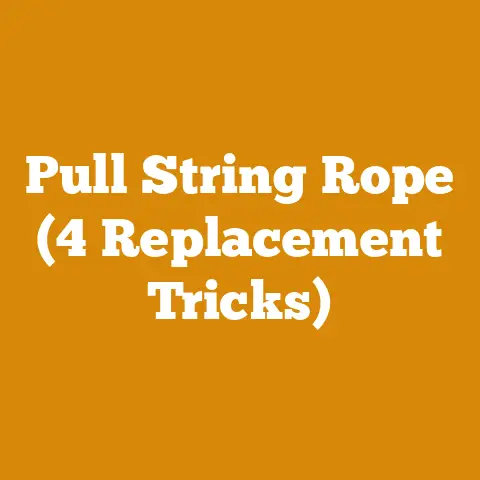Used Tree Climbing Gear (3 Bargains to Find)
Finding Bargains on Used Tree Climbing Gear
Let me share a tale about my loyal
companion, Max.
He’s a spirited dog
who loves to accompany me on my tree
climbing adventures.
As I ascend into
the canopy, he waits patiently below,
his eyes full of anticipation.
It’s in
these moments that I realize the importance
of having reliable climbing gear.
Why Consider Used Gear?
You might be asking yourself why anyone
would choose used climbing gear over new.
The simple answer is cost-effectiveness.
Many climbers upgrade their equipment regularly,
leaving behind gear that’s still in excellent
condition but at a much lower price.
A Personal Anecdote:
I once stumbled upon a barely used harness
at a garage sale.
The seller, a former climber,
was offloading his gear after switching careers.
That harness served me well for years and
became a staple in my climbing kit.
Getting Started: Understanding What You Need
Before diving into the used market, it’s crucial
to know what you’re looking for.
Different climbing
scenarios require different gear.
Here’s a breakdown:
Climbing Harnesses
Personal Experience:
When I first started climbing, my budget was tight.
I found a used harness that felt just right.
It was like
finding that perfect pair of jeans; it fit snugly and gave
me confidence.
What to Look For:
- Material: Ensure it’s made from robust materials
like nylon or polyester. - Adjustability: The more adjustable points, the better
the fit you can achieve. - Comfort: Padding in the right places can make long climbs bearable.
Safety Tip: Always check the stitching and buckles.
Any sign of wear could compromise safety.
Climbing Ropes
Insight from My Journey:
I remember buying my first used rope from a climbing buddy.
He assured me it had only been used for gym climbs and was in great shape.
Inspections to Conduct:
- Tactile Check: Run your hands along the entire length to feel for any soft spots or inconsistencies.
- Visual Inspection: Look for fraying, cuts, or unusual discoloration.
- Length Verification: Ensure it’s long enough for your typical climbs.
Safety Warning: If you find any damage or have doubts about its history, it’s better to pass.
Ascenders and Descenders
Learning from Others:
A fellow climber once shared his story of finding an almost new descender at a swap meet.
It was barely used because the previous owner preferred another brand.
Things to Examine:
- Mechanism Functionality: Test them multiple times to ensure smooth operation.
- Wear Marks: Especially check areas where metal contacts metal.
Safety Reminder: If it’s not functioning perfectly during inspection, it won’t improve with use.
Acquiring Used Gear: A Step-by-Step Guide
- Research and List Needs: Understand which gear is essential for your climbs.
Create a prioritized list. - Set Your Budget: Determine how much you’re willing to spend on each item.
- Source Reputable Sellers: Join climbing forums, check online marketplaces with buyer protection, and visit local swap meets.
- Inspect Before Purchase: If possible, inspect the gear in person or request detailed photos and history.
- Negotiate Wisely: Don’t be shy about negotiating the price.
Used gear should come at a bargain.
Expert Tip: Always have a backup option in mind in case your primary choice doesn’t work out.
Prerequisites and Required Materials
Before diving into used gear shopping, ensure you have:
- Basic Climbing Knowledge: Understand how each piece of gear functions.
- Safety Protocols Familiarity: Know the basic safety checks for each item.
- Budget Planning Skills: Stay within your financial limits to avoid overspending.
Common Pitfalls and How to Avoid Them
When shopping for used gear, there are common mistakes that many climbers make:
1. Impulse Buying
It’s easy to get caught up in the excitement of finding a bargain.
I once bought a carabiner set without inspecting them thoroughly because the price was too tempting.
Later, I discovered one had a hairline crack.
How to Avoid:
Always take your time to inspect and assess whether you truly need the item.
2. Ignoring Seller Reviews
In online marketplaces, seller ratings can tell you a lot about their reliability.
How to Avoid:
Always check reviews and ratings before making a purchase.
If the seller has dubious feedback, consider other options.
3. Overlooking Return Policies
Some sellers offer returns or exchanges on their used gear, while others don’t.
How to Avoid:
Clarify return policies before buying so you’re not stuck with unsatisfactory gear.
Tips and Warnings
Tip Box:
- Regular Gear Checks: Even after purchasing, regularly inspect your gear for wear and tear.
- Join Climbing Communities: They often have swap events or members looking to sell gear.
Warning Box:
- Never Ignore Damage: Anything less than perfect condition can fail unexpectedly.
- Beware of Counterfeits: Ensure authenticity by familiarizing yourself with brand-specific markings.
Gaining Confidence with Used Gear
Using used gear can be intimidating initially, but with experience, you’ll gain confidence in assessing and utilizing it effectively.
Here are some strategies:
1. Start Small
Begin by purchasing less critical items like chalk bags or accessory carabiners to build confidence.
2. Learn from Others
Join climbing forums or groups where experienced climbers share their success stories and tips about buying used gear.
3. Build Inspection Skills
Spend time learning how to inspect different types of climbing equipment thoroughly.
Attend workshops if available.
Advanced Considerations: When to Walk Away
There will be times when walking away from a deal is the best decision:
- If the seller seems evasive about the gear’s history.
- When visible damage is present without satisfactory explanations.
- If the price seems too good to be true without clear reasons.
Expanding Your Gear: Long-Term Strategies
Once you’re comfortable with the basics of acquiring used gear, consider these advanced strategies:
1. Building Relationships
Develop relationships with regular sellers or fellow climbers who frequently update their gear.
They can offer first dibs on quality items.
2. Swapping Gear
Organize or participate in gear swap events where you can trade your unused equipment for something you need more urgently.
3. Maintaining Your Gear
Proper maintenance extends the life of your equipment:
- Clean ropes and harnesses after use.
- Store equipment in a cool, dry place.
- Regularly lubricate moving parts of ascenders/descenders.
Conclusion: Embrace the Hunt
Finding bargains on used tree climbing gear is like going on treasure hunts with rewards that extend beyond monetary savings—it’s about joining communities, learning from each other, and ensuring safety without breaking the bank.
FAQs: Your Concerns Addressed
Q: How do I differentiate between good-quality used gear and junk?
A: Focus on visible wear signs and seller transparency about the item’s usage history.
Q: Are there particular brands that are safer to buy used?
A: Established brands like Petzl, Black Diamond, or Edelrid tend to have robust products that withstand time well.
Q: What should I prioritize when starting my used gear hunt?
A: Begin with essential safety items like harnesses and ropes, ensuring they are in top condition before moving to less critical items like accessory carabiners or slings.
Stay safe, enjoy the climb, and may you always find great deals on your next adventure!






